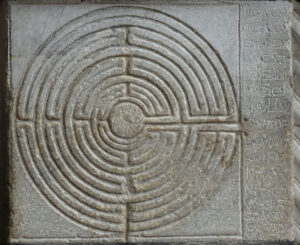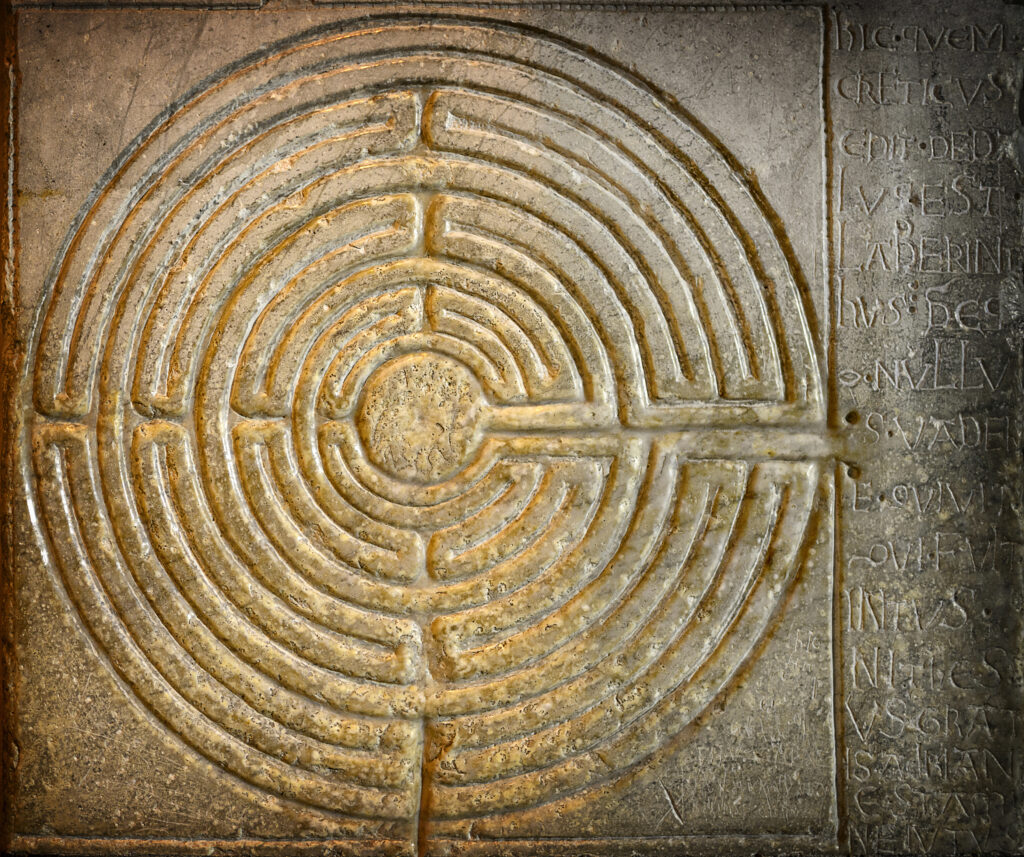Labyrinths through the years
Text and photos by Jeff Saward, February 2023
Nobody knows where or when the first labyrinth symbol was drawn, and the earliest examples are often difficult to date accurately. Despite these uncertainties, we know that some labyrinth decorated artefacts and rock carvings in southern Europe are between 3000 and 4000 years old. Early in their history they spread around the shores of the Mediterranean Sea and became associated with the Greek legend of Theseus and the Minotaur. From around 350 BCE onwards, coins issued at Knossos, the traditional location of the labyrinth in which the Minotaur was imprisoned, often bear the labyrinth symbol on their reverse. The story of Theseus and the Minotaur was evidently well known to the Romans, whose mosaic floors laid throughout the Roman Empire, in Europe and North Africa, often depicted the labyrinth surrounded by defensive walls with Theseus and the Minotaur at the centre.

At first these Christian labyrinths appeared principally in manuscripts, but during the 12th century they began to be utilised in churches and cathedrals as architectural features, especially in Italy. During the 13th century they spread to northern France, where the familiar walkable pavement labyrinths were developed. Others labyrinths formed as pebble mosaics, constructed of tiles, and carved as inscriptions were also widespread in subsequent centuries, and they enjoyed a further flourish of symbolic popularity during the Renaissance. They bloom again in the 19th century, when new church buildings and restoration projects added new labyrinths to the varied selection that survive in European churches to this day. They also found their way into civic buildings and private properties at this time, in a flurry of activity unparalleled until the late 20th century revival.

A further development during the Middle Ages saw the labyrinth flourish in Northern Europe in the form of walkable labyrinths, constructed of turf on village greens and hilltops in Britain and Germany, and of stones and boulders throughout Scandinavia and as far north as Iceland and Arctic Russia. Many of these labyrinths survive, although their precise purpose can only be inferred from folklore and local traditions.

The labyrinth also found its way far beyond Europe, perhaps 2000 years ago, as evidenced by the widespread occurrence of rock carvings, temple inscriptions, and labyrinths formed of rocks throughout Pakistan, India, Sri Lanka and Nepal. It was surely via trade from this region that labyrinths found their way to the Indonesian islands of Sumatra and Java at least 500 years ago. Likewise, it was probably around 400 years ago that labyrinths first occur in the American Southwest and Mexico, as a symbol introduced by Christian missionaries that was soon grafted onto local legends.
And now, during the last fifty years or so, the labyrinth symbol and its attendant mythology has undergone a further rapid spread and evolution, once again becoming a vibrant concept that has infiltrated into many aspects of public consciousness. It is likely that more labyrinths have been built in recent years than at any time in the past. The current fascination with the labyrinth as a contemplative and spiritual tool, a path to represent the course of life, an expression of soulful intent, is truly remarkable and has taken the concept worldwide, helped, of course, by modern technologies. This current revival of interest, just another incident in the long history of the labyrinth, will surely leave many labyrinths for future historians to ponder!








